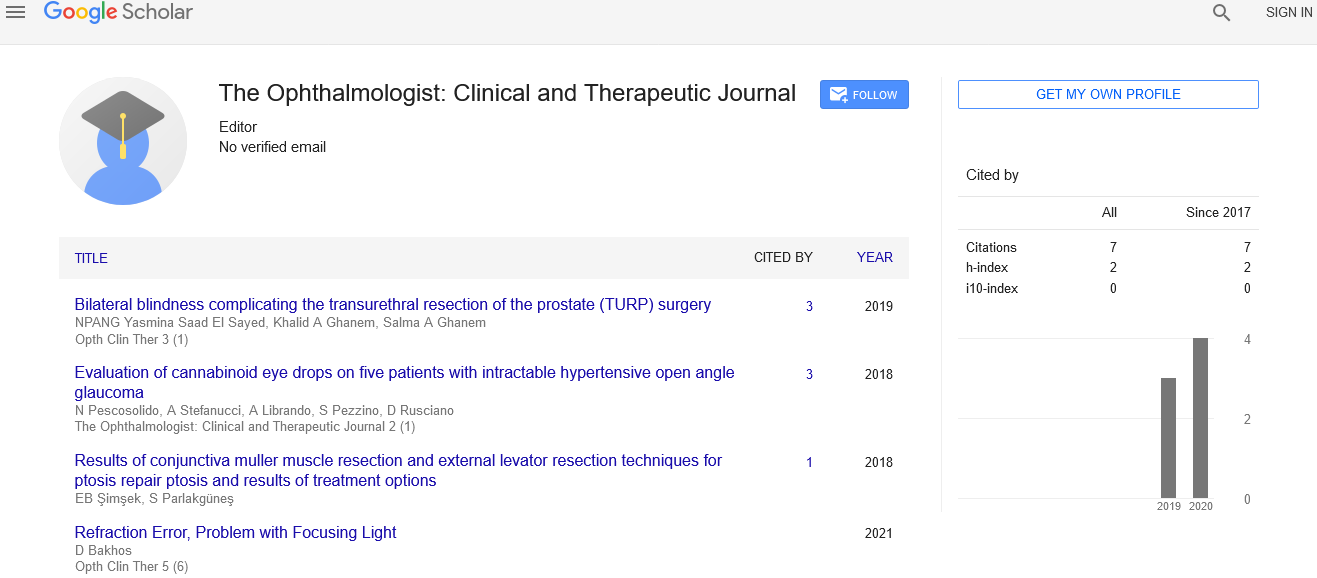Gene therapy as a solution of inherited ocular disease
Received: 08-Oct-2021 Accepted Date: Oct 22, 2021; Published: 29-Oct-2021
Citation: Chang GY. Gene therapy as a solution of inherited ocular disease. Opth Clin Ther 2021;5(5):6.
This open-access article is distributed under the terms of the Creative Commons Attribution Non-Commercial License (CC BY-NC) (http://creativecommons.org/licenses/by-nc/4.0/), which permits reuse, distribution and reproduction of the article, provided that the original work is properly cited and the reuse is restricted to noncommercial purposes. For commercial reuse, contact reprints@pulsus.com
Gene treatment is a clever type of medication conveyance that includes the engineered apparatus of the patient's cells to deliver a gene with many helpful specialists. Genes might be conveyed into cells in vitro or in vivo using viral or non-viral vectors. Uncorrected refractive mistake, untreated waterfall, age-related macular degeneration ARMD, glaucoma and diabetic retinopathy are the most widely recognized reasons for extreme visual disability around the world. Recent specialized advances have prompted the showing of the atomic premise of different visual illnesses. Visual issues with the best potential for advantage of gene treatment incorporate genetic illnesses, for example, retinitis pigmentosa, growths like retinoblastoma or melanoma, and obtained proliferative and neovascular retinal issues.
Keywords
Retinitis pigmentosa; Corneal neovascularization; Vectors; Diabetic retinopathy; Visual illnesses
Introduction
Gene exchange into visual tissues has been shown with developing practical achievement and may form into another restorative device for clinical ophthalmology in future. The guarantee of having the option to control human hereditary material to treat illnesses has for some time been an expectation for patients with untreatable infections or diseases. Gene treatment, the treatment or anticipation of sicknesses by gene exchange, is perceived as a significant logical accomplishment of the 20th century. The use of gene treatment in the treatment of visual sicknesses gives us intriguing and special thoughts [3].
Gene treatment depends on procedures for conveying gene, which is refined through gene transfer vehicles known as vectors. These vectors exemplify helpful qualities for transfer to cells. Foundational microorganism treatment has extraordinary potential for various visual conditions. Gene therapy has shown incredible potential for the treatment of infections influencing the visual surface and significant endeavours are being designated to fiery go between and neovascularization, to foster possible medicines for corneal aggravation. Gene therapy used to treat visual problems is at in beginning, and momentum treatments are essentially trial, with most human clinical preliminaries still in research state, but some of them have effectively shown empowering results [1]. Generally, the cornea is a magnificent contender for gene treatment. The eye is an incredibly particular organ, with individual designs that cooperate to catch and handle visual data. It is comprehensively partitioned into two compartments, the foremost and the back portion. Gene treatment comprises in the utilization of nucleic acids to fix, suppress, or control qualities to forestall or treat a sickness. It has arisen as another methodology for corneal sicknesses that prompts visual impairment, on account of the benefits of the cornea as far as openness, straightforwardness, simplicity of vector organization and visual observing, and capacity to perform continuous non-invasive corneal appraisal. A few corneal infections might conceivably profit from gene treatment [2]. A few models are corneal scarring, corneal neovascularization, foremost and stromal dystrophies that are connected to hereditary changes, monogenic lysosome, stockpiling problems influencing the cornea like Mucopolysaccharidosis (MPS), type VII (Sly disorder), Corneal unite dismissal and the up keep of corneal endothelial cell thickness in eye-banked corneas [5]. A wide scope of components might be capable of corneal aggravation or keratitis, including contaminations, dries eye, and problems of the eyelids, physical and substance injury, and an enormous assortment of basic illnesses. Gene treatment has shown an extraordinary potential for the treatment of illnesses influencing the visual surface of the eye; in many events gene treatment has exhibited to be preferred controlled and more productive over protein based treatment. The adequacy of exposed nucleic acids has been improved by utilizing diverse actual techniques (gene gun, electroporation or iontophoresis etc.). A large portion of the gene treatment attempts to foster an expected treatment for eye diseases.Gene treatment has an extraordinary potential to treat issues influencing the cornea, albeit most examinations are currently at preclinical levels in creature models, and clinical preliminaries in people are scant [4].
Conclusion
Gene transfer and various techniques of gene exchanging are at cutting edge stages, though gene altering approaches are still beginning. A few impediments must be tended to before a restorative item dependent on gene treatment is supported to treat corneal keratitis, including the improvement of security and adequacy of vectors, and the accomplishment of long helpful reactions.
REFERENCES
- Dias MF, Joo K, Kemp JA, et al. Molecular genetics and emerging therapies for retinitis pigmentosa: Basic research and clinical perspectives. Prog. Retin. Eye Res 2018 1;63:107-31.
- Elbadawy HM, Gailledrat M, Desseaux C, et al. Targeting herpetic keratitis by gene therapy. J. Ophthalmol. 2012 ;1-14
- Gong N, Pleyer U, Volk HD, et al. Effects of local and systemic viral interleukin-10 gene transfer on corneal allograft survival. Gene Ther. 2007;14(6):484-90.
- Hao J, Li SK, Kao WW, et al. Gene delivery to cornea. Brain Res. Bull. 2010;81(2-3):256-61.
- Holland, E., Brilakis, G., Schwartz, G. Herpes simplex keratitis, in: J.H. Krachmer, M.J. Mannis, E.J. Holland (Eds.), Cornea, II, Vol. 1. pp. 2005;1043–1074.





